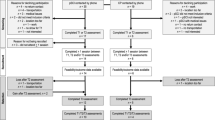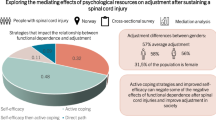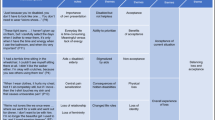Abstract
Study design
Nonrandomized clinical trial (NCT02354625).
Objectives
As a part of a Phase I clinical trial to assess the safety of autologous human Schwann cells (ahSC) in persons with chronic spinal cord injury (SCI), participants engaged in a multimodal conditioning program pre- and post-ahSC transplantation. The program included a home-based strength and endurance training program to prevent lack of fitness and posttransplantation detraining from confounding potential ahSC therapeutic effects. This paper describes development, deployment, outcomes, and challenges of the home-based training program.
Setting
University-based laboratory.
Methods
Development phase: two men with paraplegia completed an 8-week laboratory-based ‘test’ of the home-based program. Deployment phase: the first four (two males, two females) participant cohort of the ahSC trial completed the program at home for 12 weeks pre and 20 weeks post ahSC transplant.
Results
Development phase: both participants improved their peak aerobic capacity (VO2peak) (≥17%), peak power output (POpeak) (≥8%), and time to exhaustion (TTE) (≥7%). Deployment phase: pretransplant training minimally increased fitness in the two male participants (≥6% POpeak and ≥9% TTE). The two women had no POpeak changes and slight TTE changes (+2.6 and −1.2%, respectively.) All four participants detrained during the posttransplant recovery period. After posttransplant retraining, all four participants increased TTE (4–24%), three increased VO2peak (≥11%), and two increased POpeak (≥7%).
Conclusions
Home-based strength and condition programs can be effective and successfully included in therapeutic SCI trials. However, development of these programs requires substantial content knowledge and experience.
Similar content being viewed by others
Log in or create a free account to read this content
Gain free access to this article, as well as selected content from this journal and more on nature.com
or
Data availability
All data generated and analyzed in this study are available from the corresponding author on request.
References
Gant KL, Nagle KG, Cowan RE, Field-Fote EC, Nash MS, Kressler J, et al. Body system effects of a multi-modal training program targeting chronic, motor complete thoracic spinal cord injury. J Neurotrauma. 2018;35:411–23.
Anderson KD, Cowan RE, Horsewell J. Facilitators and barriers to spinal cord injury clinical trial participation: multi-national perspective of people living with spinal cord injury. J Neurotrauma. 2016;33:493–9.
Jacobs PL, Nash MS, Rusinowski JW. Circuit training provides cardiorespiratory and strength benefits in persons with paraplegia. Med Sci Sports Exerc. 2001;33:711–7.
Kressler J, Burns PA, Betancourt L, Nash MS. Circuit training and protein supplementation in persons with chronic tetraplegia. Med Sci Sports Exerc. 2014;46:1277–84.
Nash MS, van de Ven I, van Elk N, Johnson BM. Effects of circuit resistance training on fitness attributes and upper-extremity pain in middle-aged men with paraplegia. Arch Phys Med Rehabilit. 2007;88:70–5.
Lai B, Rimmer J, Barstow B, Jovanov E, Bickel CS. Teleexercise for persons with spinal cord injury: a mixed-methods feasibility case series. JMIR Rehabilit Assist Technol. 2016;3:e8.
Nightingale TE, Walhin JP, Thompson D, Bilzon JLJ. Impact of exercise on cardiometabolic component risks in spinal cord-injured humans. Med Sci Sports Exerc. 2017;49:2469–77.
Sasso E, Backus D. Home-based circuit resistance training to overcome barriers to exercise for people with spinal cord injury: a case study. J Neurol Phys Ther. 2013;37:65–71.
Ma JK, West CR, Martin Ginis KA. The effects of a patient and provider co-developed, behavioral physical activity intervention on physical activity, psychosocial predictors, and fitness in individuals with spinal cord injury: a randomized controlled trial. Sports Med. 2019;49:1117–31.
Maher JL, Cowan RE. Comparison of 1- versus 3-minute stage duration during arm ergometry in individuals with spinal cord injury. Arch Phys Med Rehabilit. 2016;97:1895–900.
Mayhew JL, Prinster JL, Ware JS, Zimmer DL, Arabas JR, Bemben MG. Muscular endurance repetitions to predict bench press strength in men of different training levels. J Sports Med Phys Fit. 1995;35:108–13.
Ribeiro Neto F, Guanais P, Dornelas E, Coutinho ACB, Costa RRG. Validity of one-repetition maximum predictive equations in men with spinal cord injury. Spinal Cord. 2017;55:950–6.
Benson C, Docherty D, Brandenburg J. Acute neuromuscular responses to resistance training performed at different loads. J Sci Med Sport. 2006;9:135–42.
Cowan RE, Ginnity KL, Kressler J, Nash MS, Nash MS. Assessment of the talk test and rating of perceived exertion for exercise intensity prescription in persons with paraplegia. Top Spinal Cord Inj Rehabilit. 2012;18:212–9.
Bouchard C, Rankinen T. Individual differences in response to regular physical activity. Med Sci Sports Exerc. 2001;33:S446–51.
Bouchard C. Individual differences in the response to regular exercise. Int J Obes Relat Metab Disord. 1995;19(Suppl 4):S5–8.
Timmons JA. Variability in training-induced skeletal muscle adaptation. J Appl Physiol. 2011;110:846–53.
Nash MS, Groah SL, Gater DR Jr, et al. Identification and Management of Cardiometabolic Risk after Spinal Cord Injury: Clinical Practice Guideline for Health Care Providers. Top Spinal Cord Inj Rehabil. 2018;24:379–423. https://doi.org/10.1310/sci2404-379.
American College of Sports Medicine, Riebe D, Ehrman JK, Liguori G, Magal M. ACSM’s guidelines for exercise testing and prescription. 10th ed. Philadelphia, PA: Wolters Kluwer Health; 2018.
Martin Ginis KA, van der Scheer JW, Latimer-Cheung AE, Barrow A, Bourne C, Carruthers P, et al. Evidence-based scientific exercise guidelines for adults with spinal cord injury: an update and a new guideline. Spinal Cord. 2018;56:308–21.
Nightingale TE, Metcalfe RS, Vollaard NB, Bilzon JL. Exercise guidelines to promote cardiometabolic health in spinal cord injured humans: time to raise the intensity? Arch Phys Med Rehabilit. 2017;98:1693–704.
Simmons OL, Kressler J, Nash MS. Reference fitness values in the untrained spinal cord injury population. Arch Phys Med Rehabilit. 2014;95:2272–8.
Nash MS, Jacobs PL, Woods JM, Clark JE, Pray TA, Pumarejo AE. A comparison of 2 circuit exercise training techniques for eliciting matched metabolic responses in persons with paraplegia. Arch Phys Med Rehabilit. 2002;83:201–9.
Acknowledgements
The authors would like to acknowledge the work of Kathleen Nagle.
Funding
This work was supported by The Miami Project to Cure Paralysis, Buoniconti Fund to Cure Paralysis, and the Bryon Riesch Paralysis Foundation.
Author information
Authors and Affiliations
Contributions
All authors were responsible for research conception and design and critical review and revision of the article. JM, REC, and KDA were involved converting the CRT exercises to band/dumbbell exercises. JM was additionally involved in data collection, analysis, and drafting this paper.
Corresponding author
Ethics declarations
Conflict of interest
The authors declare that they have no conflict of interest.
Ethical approval
We certify that all applicable institutional and governmental regulations concerning the ethical use of human volunteers were followed during the course of this research.
Additional information
Publisher’s note Springer Nature remains neutral with regard to jurisdictional claims in published maps and institutional affiliations.
Rights and permissions
About this article
Cite this article
Maher, J.L., Anderson, K.D., Gant, K.L. et al. Development and deployment of an at-home strength and conditioning program to support a phase I trial in persons with chronic spinal cord injury. Spinal Cord 59, 44–54 (2021). https://doi.org/10.1038/s41393-020-0486-7
Received:
Revised:
Accepted:
Published:
Issue date:
DOI: https://doi.org/10.1038/s41393-020-0486-7
This article is cited by
-
Engineered Tools to Advance Cell Transplantation in the Nervous System Towards a Clinical Reality
Current Transplantation Reports (2024)
-
Current progress of rehabilitative strategies in stem cell therapy for spinal cord injury: a review
npj Regenerative Medicine (2021)



